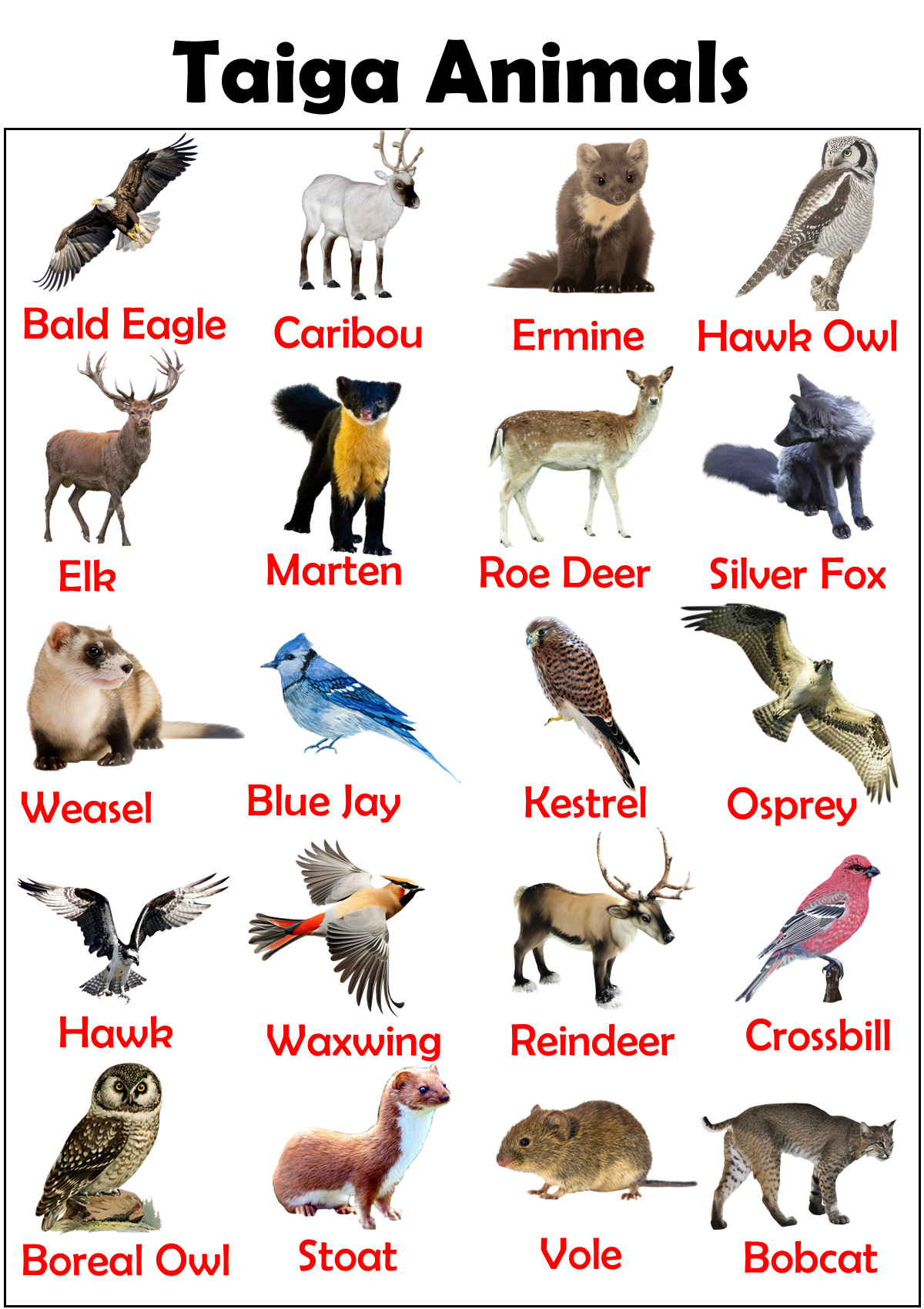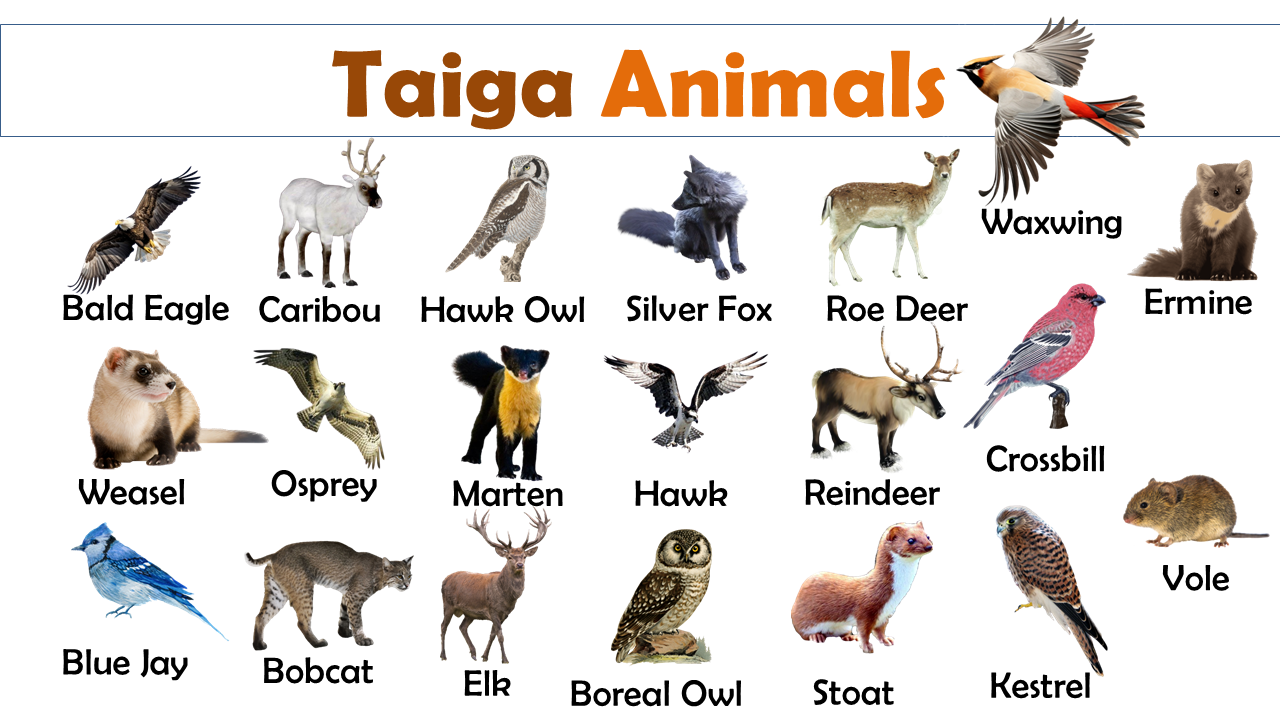The taiga, also known as the boreal forest, is a vast and cold forest that stretches across the northern parts of the world. This special place is home to a variety of animals that are adapted to the cold climate. In this blog post, we’ll explore some of these tough creatures, like the sturdy moose and the clever fox, who make their homes among the dense trees and snowy landscapes. You’ll learn new English words to describe these animals and their unique environment. Let’s dive into the world of taiga animals!
What are Taiga Animals?
The taiga, also known as the boreal forest, is a biome characterized by coniferous forests consisting mostly of pines, spruces, and larches. This biome is found in the northern regions of North America, Europe, and Asia, and is known for its cold climate and limited species diversity compared to more temperate or tropical ecosystems. Animals in this biome have adapted to the cold and often have thick fur, fat reserves, and other adaptations to survive long winters and short summers.
List of Taiga Animals
- American Black Bear
- Amur Leopard
- Bald Eagle
- Bobcat
- Brown Bear
- Canadian Lynx
- Caribou
- Common Raven
- Coyote
- Eastern Chipmunk
- Elk
- Ermine
- Eurasian Lynx
- European Pine Marten
- Fisher
- Gray Wolf
- Great Grey Owl
- Grizzly Bear
- Hawk Owl
- Hoary Marmot
- Least Weasel
- Marten
- Moose
- Mountain Hare
- Northern Flying Squirrel
- Northern Goshawk
- Pine Grosbeak
- Pine Marten
- Red Fox
- Red Squirrel
- Red-Backed Vole
- Reindeer
- River Otter
- Roe Deer
- Ruffed Grouse
- Siberian Tiger
- Silver Fox
- Snowshoe Hare
- Snowy Owl
- Stoat
- Striped Skunk
- Timber Wolf
- Tundra Swan
- Weasel
- Western Tanager
- White-Tailed Deer
- Wolverine
- Wood Bison
- Wood Frog
- Woodland Caribou
- Siberian Jay
- Black-Capped Chickadee
- Blue Jay
- Bohemian Waxwing
- Boreal Chickadee
- Boreal Owl
- Canada Goose
- Crossbill
- Eastern Kingbird
- Golden Eagle
- Hawk
- Kestrel
- Osprey
- Peregrine Falcon
- Spruce Grouse
- Tawny Owl
- Trumpeter Swan
- Vole
- Waxwing
- Yellow-Bellied Sapsucker
Explore More Animal Vocab:

Taiga Animals Vocabulary and Their Facts
1. American Black Bear
The American Black Bear is common across North America, including the taiga. Adapting to the forest’s rugged terrain and harsh climate, it hibernates during the winter. Omnivorous, it feeds on fruits, nuts, and small mammals, contributing to seed dispersal. Bears can weigh up to 600 pounds and play a crucial role in their ecosystems.
2. Amur Leopard
The Amur Leopard, one of the most endangered cats globally, inhabits the taiga’s fringes. Known for its beautiful, spotted coat and impressive agility, it hunts deer, boar, and smaller animals. Conservation efforts are critical as only about 70 individuals remain in the wild, mainly due to habitat loss and poaching.
3. Bald Eagle
Iconic in North America, the Bald Eagle thrives in the taiga near large bodies of open water. Known for its white head, brown body, and hooked yellow beak, this raptor primarily feeds on fish. It plays a vital role in its habitat as a top predator, maintaining the balance of aquatic life.
4. Bobcat
The Bobcat, a North American wild cat, is smaller than its relatives but fiercely territorial. It has tufted ears, a whiskered face, and a distinctive short, “bobbed” tail. In the taiga, it preys on rabbits, birds, and occasionally deer, showing remarkable adaptability to various environments.
5. Brown Bear
A symbol of the wilderness, the Brown Bear has a massive presence across the taiga. With its thick fur and fat layers, it is well-adapted to cold climates. It has a varied diet that includes fish, berries, and small mammals. Bears play a key role in the ecosystem, influencing the populations of other species.
6. Canadian Lynx
The Canadian Lynx, with its thick fur and large padded paws, is perfectly adapted to the snowy landscapes of the taiga. This elusive cat primarily hunts snowshoe hares, and its population fluctuates with the hare’s cycles, highlighting a unique predator-prey relationship in this biome.
7. Caribou
Caribou, or reindeer, are vital to indigenous cultures and taiga ecosystems. They undertake long migrations across the taiga, feeding on lichens and plants. Their movements and grazing patterns significantly impact the vegetation and soil health, supporting a diverse array of other wildlife.
8. Common Raven
The Common Raven, an intelligent and versatile bird, thrives in the taiga. It is known for its problem-solving skills and complex social behaviors. Ravens can mimic sounds and often scavenge, playing an essential role in the ecosystem as a cleaner of carrion and waste.
9. Coyote
Originally native to plains and deserts, the Coyote has expanded its range into the taiga. Adaptable and opportunistic, it feeds on a variety of foods from small mammals to fruits. Coyotes affect the populations of other small predators and are integral to the ecological balance.
10. Eastern Chipmunk
The Eastern Chipmunk is a small, striped rodent frequently seen scurrying through the taiga’s underbrush. It gathers and stores seeds and nuts in its burrows, inadvertently aiding in forest regeneration. Its activities also influence the dispersal of mycorrhizal fungi, crucial for tree growth.
11. Elk
The Elk, or Wapiti, is one of the largest species of the deer family, native to North America and eastern Asia. In the taiga, these majestic animals graze on grasses and shrubs, shaping the landscape and providing prey for large predators like wolves and bears.
12. Ermine
The Ermine, a small carnivorous mammal, sports a white winter coat that allows it to blend into the snowy environment. It preys on rodents and birds, displaying remarkable agility and ferocity. Its fur, particularly valued in the fur trade, has historically been a symbol of royalty in Europe.
13. Eurasian Lynx
The Eurasian Lynx, larger than its Canadian counterpart, roams the vast stretches of the taiga in Europe and Asia. It preys primarily on hoofed mammals like deer, contributing to controlling these populations, which helps maintain forest health and diversity.
14. European Pine Marten
The European Pine Marten, a member of the mustelid family, is known for its arboreal (tree-dwelling) habits. This elusive creature preys on small mammals and birds, and its presence indicates a healthy, undisturbed forest ecosystem.
15. Fisher
The Fisher is a medium-sized mammal, misleadingly named as it rarely eats fish. Instead, it preys on hares and rodents and is one of the few predators of porcupines. Fishers are crucial for controlling prey populations, which helps maintain a balanced ecosystem.
16. Gray Wolf
The Gray Wolf, a keystone species in the taiga, plays a critical role in maintaining the health of its ecosystem. It preys on sick and weak animals, thereby supporting natural selection and biodiversity. Wolves also influence the distribution and behavior of other wildlife, shaping the habitat.
17. Great Grey Owl
The Great Grey Owl, with its large size and distinctive facial disc, is a formidable predator in the taiga. It hunts primarily at night, using its exceptional hearing to locate prey under thick snow. Owls contribute to controlling rodent populations, crucial for forest health.
18. Grizzly Bear
The Grizzly Bear, a subspecies of the brown bear, is distinguished by its large size and fearsome claws. It has a varied diet that helps to keep different species’ populations in check. Grizzlies also help to fertilize the forest floor with fish remains and other food leftovers.
19. Hawk Owl
The Hawk Owl, unusual among owls for its daytime hunting habits, can be seen perched on tree tops in the taiga. It preys on small mammals and birds, its keen vision adapting to the dim light of its northern habitat. This owl’s presence indicates a healthy rodent population.
20. Hoary Marmot
The Hoary Marmot, known for its loud whistle, lives in colonies across the taiga. These marmots play a significant role in their ecosystem by aerating the soil and promoting plant growth through their digging activities, which also create habitats for other species.
21. Least Weasel
The Least Weasel, the smallest member of the mustelid family, is a fierce predator despite its diminutive size. It preys on rodents, helping to control these populations, which can otherwise become pests. The weasel’s presence is vital for maintaining the ecological balance.
22. Marten
Martens, with their slender bodies and bushy tails, are adept climbers that hunt birds and small mammals in the taiga. They play an important role in controlling the populations of their prey, thus maintaining a balanced ecosystem.
23. Moose
The Moose is the largest of the deer species, with a diet that includes shoots, leaves, and aquatic plants. This grazing helps to keep vegetation in the taiga in check, which can influence the types of species that the habitat can support.
24. Mountain Hare
The Mountain Hare, with its winter white coat, is well adapted to the snowy conditions of the taiga. It feeds on bark, buds, and berries, playing a crucial role in seed dispersal and vegetation dynamics in its habitat.
25. Northern Flying Squirrel
The Northern Flying Squirrel glides between trees using a membrane between its limbs. It feeds on nuts, seeds, and fungi, playing a crucial role in spore dispersal for various mushrooms, which are essential for forest health.
26. Northern Goshawk
The Northern Goshawk, a fierce bird of prey, is known for its agility in flight, which it uses to maneuver through dense forests hunting birds and mammals. This raptor’s presence helps control populations of these animals and maintains a balanced ecosystem.
27. Pine Grosbeak
The Pine Grosbeak, a large member of the finch family, feeds on seeds and buds. This bird’s feeding habits help to spread plant seeds, contributing to the regeneration of its forest habitat.
28. Pine Marten
The Pine Marten, similar to its relative the European Pine Marten, thrives in the dense forests of the taiga. It preys on small mammals and birds, playing a significant role in controlling their populations and maintaining ecological balance.
29. Red Fox
The Red Fox, with its striking orange fur, is a versatile predator in the taiga. It eats rodents, rabbits, and even fruits, adapting its diet to the seasons. Foxes are important for controlling pest populations, which helps prevent crop and tree damage.
30. Red Squirrel
The Red Squirrel is a small and agile tree-dweller, primarily feeding on nuts and seeds. Its activities include collecting and storing food, which impacts forest regeneration as forgotten caches often sprout new growth.
